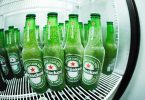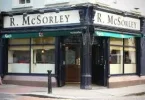UK’s food-led licensed premises 15% up
Those are among the key findings of the third edition of Future Shock, the exclusive series of insights into the UK’s eating and drinking out sectors from CGA and the Association of Licensed Multiple Retailers which recently re-branded itself to UKHospitality following a merger with the British Hospitality Association.
Health issues are having a significant impact on the market with three in five out-of-home diners saying they proactively try to lead a healthy lifestyle. Research showing falling alcohol consumption and rising demand for soft drinks highlights the need to cater for health-conscious consumers and young urban people in particular, states the data and research consultancy for the out-of-home food and drinks market.
The report identifies several challenges facing the out-of-home eating- and drinking-out markets including rising property and people costs and it warns of a looming crisis in staffing as a result of Brexit.
With non-British nationals accounting for nearly a quarter of employees in UK hospitality and tourism — rising to nearly two-thirds in London — operators will be closely watching the outcome of Brexit negotiations and planning strategies to improve their recruitment and retention.
Future Shock’s report also found that there’s been a 14.9% increase in Britain’s food-led licensed premises in the last five years (to around 45,500 units) and a 10.4% decline in the number of drink-led outlets. 47% of British consumers now eat out at least once a week with 45.5% of pubs and bars’ sales now derived from food.
“This is a time of huge change in out-of-home eating and drinking” said Jamie Campbell, CGA’s Business Unit Director, “and our latest edition of Future Shock spotlights three of the most pressing issues: technology, health and Brexit.
UKHospitality’s Chief Executive Kate Nicholls added, “This has been a very busy year for the sector with battles on business rates, Living Wage, lease reform, the apprenticeship levy and the sugar tax. In the battle for share of voice within government, insight, intelligence and information are king and that’s why the Future Shock series is so important.”
Tech savvy
CGA’s Brand Track research from October 2016 indicates that almost six in 10 out-of-home diners say they may check bar/restaurant websites before they visit.
Booking tables online has become a widespread behavior with around half of out of home diners now doing so.
Health & Wellness
The proportion of adults in Great Britain who claim to have had an alcoholic drink in the last seven days declined from 64% in 2005 to 46% in the report. Over the same period, the proportion of adults claiming to be teetotal has risen from 19% to 21%, a trend led by 16 to 24 year-olds where the claimed teetotalism rate has increased from 19% to 27%.
Defra data suggests that 31% of household food and drink expenditure now takes place out of home.
CGA’s Brand Track consumer research from October 2016 showed almost 50% of out-of-home diners say that they often or always take the availability of healthy options into account when choosing where to eat out.
However, one in four young diners say they always take the availability of health options into consideration when choosing where to eat, compared to only 11% of those aged 55+.
Healthy options are also more influential for those with degree-level education and those with higher household incomes.
Additionally, the inclusion of nutritional information on menus is claimed to influence around four in 10 out of home diners’ choice of food when eating out and younger diners, the more educated and the more affluent, are again more likely to be influenced than others.
In terms of ingredients, the three key targets of the health lobby – sugar, fat and salt – are each said to be important (or very important) factors in the selection of a meal by about half of out-of-home diners. They are significant factors for diners than calorie counts.
It’s notable that the consumers who eat out most often are also the more health-conscious. More than one in three of those who eat out at least three times a week say they always take healthy options into account and over 50% say nutritional information is an influence on what they choose to eat in restaurants. By contrast only 13% of those who eat out less often than once a month claim to always take healthy options into account and around 30% say their choice is influenced by nutritional information.
A CGA Brand Track survey from July last year found that 60% of adults agreed or strongly agreed with the statement, “I would like to see more healthy soft drinks on offer”.
The report also found a 0.1% increase in beer & cider sales between 2016 and 2017, a 0.2% increase in soft drinks sales, a 2.5% increase in spirits sales and a 1.1% increase in wine/Champagne sales.
Macro Market Shape & Size
Andy Wingate, On-Trade Category Controller for Heineken also gave his views on the shape and size of the UK alcohol market and its consumers as part of the CGA report.
Almost 25 million Hectolitres of alcoholic beverages are consumed in the on-trade channel every year, he stated, “The revenue this brings to pubs and bars is increasing (up 1%) despite a slight decline in volume in the last year of 2% as consumers go to more premium outlets and choose higher-priced drinks.
“Long alcoholic drinks hold the lion’s share of this with 90% of the volume held within beer and cider,” he added.
And within this, he pointed out, consumers are looking to discover new things and engaging in more local, crafted products.
“Therefore, we now see the number of on-trade outlets ranging craft beer has jumped to more than two in five outlets today from only one in five in 2015.”
Looking Forward
According to Andy Wingate, “The challenging marketplace, reducing alcohol consumption and movement of drinking occasions to the off-trade will make it tough for outlets for the foreseeable future. However, as with the past few years of the recession, a strong business plan, knowledgeable staff and a clear proposition are key to success”.
Citing CGA Strategy and Kantar Alcovision he added, “Research suggests that consumers spend on average 10% more on visits when they rate the service as ‘very good’. Equally, consumers who rate the atmosphere as ‘very good’ are three times as likely to feel they got value for money from a visit and those who feel they get value for money are 2.4 times more likely to come back”.
Future Shock also includes reflections on the 25th anniversary of the ALMR from industry leaders who’ve been instrumental in its growth.








